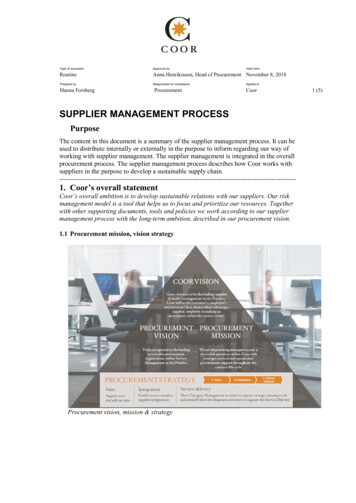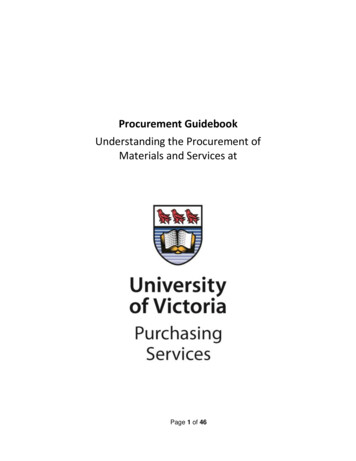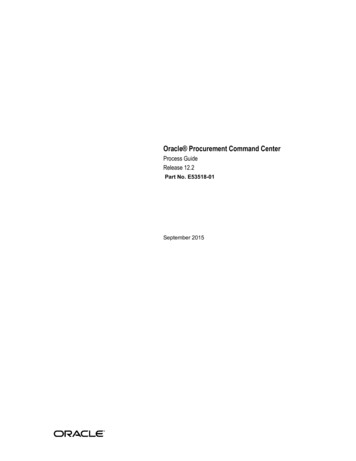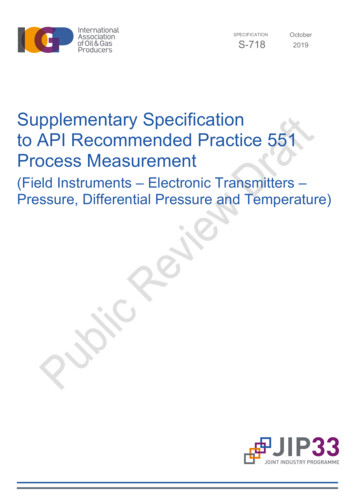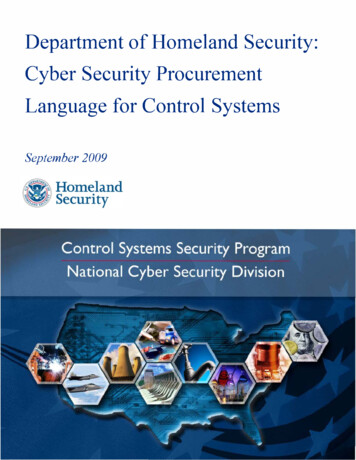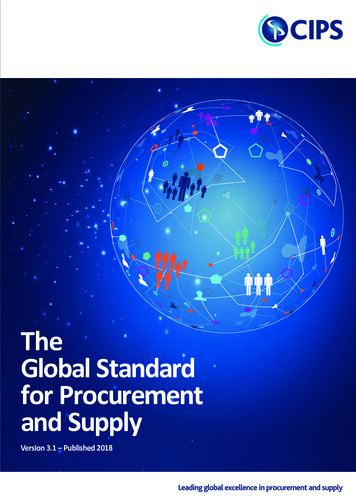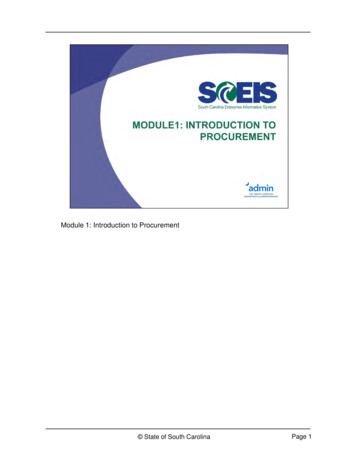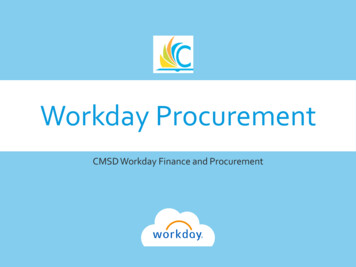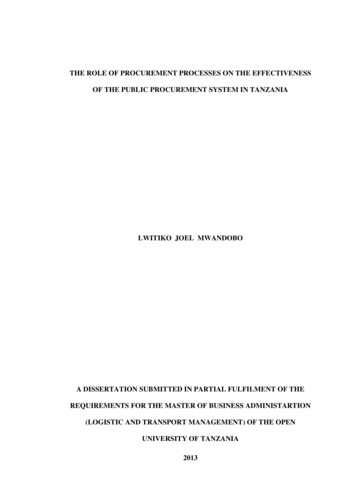
Transcription
THE ROLE OF PROCUREMENT PROCESSES ON THE EFFECTIVENESSOF THE PUBLIC PROCUREMENT SYSTEM IN TANZANIALWITIKO JOEL MWANDOBOA DISSERTATION SUBMITTED IN PARTIAL FULFILMENT OF THEREQUIREMENTS FOR THE MASTER OF BUSINESS ADMINISTARTION(LOGISTIC AND TRANSPORT MANAGEMENT) OF THE OPENUNIVERSITY OF TANZANIA2013
iiCERTIFICATIONThe undersigned certifies that he has read and hereby recommends for acceptance bythe Open University of Tanzania a dissertation entitled "The Role of ProcurementProcesses on the effectiveness of Public Procurement System in Tanzania" inpartial fulfilment of the requirements for the degree of Master of BusinessAdministration (Logistic and Transport) of the Open University of Tanzania.Dr.Omari K. Mbura(Supervisor)Date: .
iiiCOPYRIGHTThis dissertation is copyright material protected under, the Copyright Act 1999 andother international and national enactments in that behalf on intellectual property. Itmay not be reproduced by any means in full or part, except for short extracts in fairdealing, for research or private study, critical scholarly review or discourse withoutthe written permission of the author or the Open University of Tanzania in thatbehalf.
ivDECLARATIONI, Lwitiko Joel Mwandobo declare that this submission is my own work and that ithas not been presented and will not be presented to any other University for a similaror any other degree award.Signature.Date
vDEDICATIONWith my heart, this dissertation is dedicated to my lovely wife, Mrs. Tumaini E.Lwitiko and our children, Gerald, Gabriel and Getrude for their understanding andpatience throughout the study.
viACKNOWLEDGEMENTSMy foremost gratitude goes to the Almighty God for his guidance in undertaking thisstudy. It is through God's will that made this vital assignment possible.Secondly, I am highly indebted to my supervisor Dr. Omar K. Mbura, for histireless support on mentorship and constructive academic criticism. He providedabundance guidance as he particularly read draft after draft of my dissertation. Manythanks are extended to Dr.Salim who taught me research methodology andtechniques. The knowledge gained proved a positive impact to this study.I feel indebted to my employer for tolerance and human kind for allowing to pursuethe masters programme. I know, somewhere there were inconviences because of thepursuance of this programme. This particulary appreciation goes to my supervisor,Mr. Deogratius B. Kumalija and colleagues under the department for their valuablesupport and the encouragement they provided to me during the entire process of thestudy.Undertaking and accomplishment of this study was, in many ways, made possible bythe tireless support of my family and friends in and outside the Open University ofTanzania. I thank them all for their warmth, solidarity and patience, especiallyduring the final stages of the research. In particular I thank my lovely wife, Mrs.Tumaini E. Lwitiko. May Almighty God bless you all.
viiABSTRACTThe study was triggered by the fact that the government has made number of efforts inaddressing weaknesses in the public procurement process. However there stillcomplaints that public procurement processes are characterized by delays, poor qualityand non cost effective delivery. This study sought to analyze procurement processes inachieving effectiveness of the public procurement system. The study focused onprocuring entities based in Dar es Salaam due to budget constraints and existence ofmajor procuring entities in terms of procurement volume. Explanatory research designwas used to analyse the procurement proceses. The study used structured questionnairesand interviews as primary tools for data collection. A total of 119 respondents out of theexpected 155 respondents returned the survey instruments. The study revealed thatprocuring entities do not conduct market survey for establishing cost estimates,inadequate users cooperation with PMU staff and poor solicitation documents due toinadequate technical specifications, schedule of requirements, and drawings and poorterms and conditions of contract. The weak evaluation critieria and inadequate tenderevaluations, and delays in contract awards are hampering efficient procurement processwhich results to ineffective procurement system. Furthermore weak controls inprocurement contracts for payments to delivery of substandard goods or services anddelays of due payments to suppliers or contractorsand generally poor contractmanagement were noted. The study recommends that procuring entities should conductmarket survey for cost estimates of major procurements and enhance cooperationbetween User Departmemnts and PMU staff.
viiiTABLE OF CONTENTSCERTIFICATION .iiCOPYRIGHT . iiiDECLARATION. ivDEDICATION. vACKNOWLEDGEMENT . viABSTRACT .viiLIST OF ABBREVIATIONS AND ACRONYMS . xiiiLIST OF TABLES . xiiiLIST OF FIGURES . xiiiCHAPTER ONE . 11.0 INTRODUCTION AND BACKGROUND OF THE STUDY . 11.1Introduction . 11.1.1 Background of Public Procurement Reform in Tanzania . 11.1.2 The Background of the Study . 41.2Statement of the Problem . 51.3Research Objectives . 71.4Research Questions . 81.5Relevance of the Study . 81.6Organization of the Study . 9CHAPTER TWO . 102.0 LITERATURE REVIEW . 102.1Overview . 102.2Definitions of Concepts . 10
ix2.2.1 Procurement . 102.2.2 Public Procurement . 112.2.3 Public Funds. 112.2.4 Procurement Process . 122.2.5 Value for Money . 122.3Theoretical Analysis of the Study . 132.3.1Principles of Public Procurement System . 132.3.2Procurement Legal Framework in Tanzania . 172.3.3Procurement set up Within Procuring Entity . 182.3.4Procurement Complaints Review Mechanism . 202.3.5Procurement Methods in Public Procurement. 222.3.6Procurement Process . 242.3.6.1 Tendering Process . 272.3.6.2 Contract Management . 312.4Empirical Studies . 332.4.1General Studies . 332.4.2Studies in Africa . 342.4.3Studies in Tanzania . 352.5Research Gap . 372.6Conceptual Framework . 38CHAPTER THREE . 423.0 RESEARCH METHODOLOGY . 423.1Overview . 423.2Reasearch Strategies and Design . 42
x3.3Survey Population . 433.4Area of the Study . 443.5Sampling Design . 443.5.1 Sampling Frame . 443.5.2Sampling Technique . 453.6Variables and Measurement Procedures . 463.7Methods of Data Collection . 463.7.1Primary Data Collection . 473.7.2 Secondary Data Collection . 473.8Data Reliability and Validity . 483.9Data Processing and Analysis . 48CHAPTER FOUR . 494.0 DATA PRESENTATION, ANALYSIS AND DISCUSSION OF THEFINDINGS . 494.1Introduction . 494.2Characteristics of the Respondents . 494.3Findings, Analysis and Discussion . 514.3.1 Procurement Planning Process and Effectiveness of Public ProcurementSystem . 524.3.1.1 Cost Estimate/Budget for Procurement Requirements . 534.3.1.3 Use of Procurement Method as per Procurement Plan . 564.3.1.4 Proper Planning of Tender Board Meetings . 564.3.1.5 Timely Approval and Issuance of the General Procurement Notice to thePublic. 57
xi4.3.1.6 Publication of General Procurement Notice in PPRA's Website, PE'sWebsite and Local Newspapers For Public Access . 584.3.2 Tendering Process and Effectiveness of the Public Procurement System . 594.3.2.1 Timely and Appropriate Submission of Procurement Requirements . 594.3.2.3 Advertisement of Tender Opportunities . 634.3.2.4 Adequacy of the Tender Board Quorum . 654.3.2.5 Timely Tender Evaluation . 664.3.2.6 Conducting Due Diligence Prior to Award of Tender . 684.3.2.7 Adhering to the Original Tender Validity Period . 694.3.2.8 Adherence to Tender Evaluation Criteria . 714.3.2.9 Verification of Succesful Bidder's Price to the Market . 734.3.3 Contract Management and Effectiveness of the Public Procurement System . 754.3.3.1 Appointment of Contract Manager . 754.3.3.2 Preparation of Contract Documents . 774.3.3.4 Procurement Records Keeping. 864.3.3.3 Contract Execution and Monitoring. 82CHAPTER FIVE . 895.0 SUMMARY OF THE FINDINGS, CONCLUSION ANDRECOMMENDATIONS . 895.1 Introduction . 895.2 Summary of the Findings . 895.3 Implications of the Results. 945.4 Conclusion . 955.5 Recommendations . 97
xii5.5.1 Improvement of Procurement Processes. 975.5.2 Procurement Capacity to the Public Entities . 995.6 Limitations of the Study. 1015.7 Area for Future Studies . 102REFERENCES . 103APPENDICES . 110
xiiiLIST OF TABLESTable 4.1: Summary of Response Rate . 50
xivLIST OF FIGURESFigure 2.1: Procurement Legal Frame Work within Procuring Entities . 18Figure 2.2 : Procurement Complaints Review System in Tanzania . 21Figure 2.3: Conceptual Framework for the study . 38Figure 4.1:Distribution of the Respondents' Years Experience . 50Figure 4.2 : Respondents' Opinions on Procurement Planning Process . 53Figure 4.3: Crosstabulations to Cost Estimates Basing on Market Survey . 54Figure 4.4: Submission Of Appropriate And Timely Procurement Requirements . 60Figure 4.5: Response on Adequacy of the Bidding Documents . 61Figure 4.6: Crosstabulation on Adequacy of Bidding Document . 62Figure 4.7: Response on Publishing Procurement Opportunities in AppropriateMedia . 64Figure 4.8: Response on Delays by Tender Board Quorum . 66Figure 4.9: Respondents' Opinions to Tender Evaluation Completion on TimeFigure 4.10: Respondents' Opinions on Conducting Due Diligence to Suppliers,Contractors and Service Providers . 69Figure 4.11: Respondents' Opinions on Bid Validity Period . 70Figure 4.12: Respondents' Opinions on Compliance to Tendering Evaluationcriteria by PEs . 72Figure 4.13: Respondents' Opinions on Tendering Evalauation Criteria bySuppliers . 73Figure 4.14: Respondents' opinions on Bidders' price against market price. 74Figure 4.15: Opinions on Appointment of Appropriate Contract Manager . 75
xvFigure 4.16: Respondents' Opinions on Preparation of Contract Documents and ItsImplementation .78Figure 4.17: Respondents' Opinions on Preparation of Contract Documents .78Figure 4.18: Crosstabulations on Sufficeint Provisions for Controlling Delays ofWorks or Goods Delivery . 79Figure 4.19: Crosstabulations on Provision of Adequate Controls on EffectingPayments To Suppliers or Contractors . 80Figure 4.20: Respondents' opinions on Contract execution and Monitoring . 82Figure 4.21: Crosstabulation on Preparation of Inspection reports for Goodsand Progress reports for Works. 86Figure 4. 22: Maintainance of procurement records within PEs. 87Figure 4.23: Crosstabulations on Responses from PEs on Procurement Records .88
xviLIST OF ABBREVIATIONS AND ACRONYMSAOAccounting OfficerCPARCountry Procurement Assessment ReportCTBCentral Tender BoardCUISCommon Use Items and ServicesEPCEuropean Policy Committee of European CommissionGNGovernment NoticeGOJGovernment of JamaicaMOFMinistry of FinanceNPPPUNational Public Procurement Policy UnitPCCBPrevention and Combating Corruption BureauPEsProcuring EntitiesPMUProcurment Management UnitPPAPublic Procurement ActPPAAPublic Procurement Appeals AuthorityPPRAPublic Procurement Regulatory AuthorityPPUProcument Policy UnitPSPTBProcurement and Supplies Proffessional and Technicians BoardOECDOrganisation for Economic Cooperation and DevelopmentRTTRepublic of Trindad and TobagoSPBState Procurement Board of South AustarliaSPSSStatistical Package for Social Science
1CHAPTER ONE1.0 INTRODUCTION AND BACKGROUND OF THE STUDY1.1 IntroductionThis chapter introduces the study on the role played by procurement function in thepublic expenditure management and various public procurement reforms inTanzania. The need for procurement processes in achieving effective publicprocurement system are discussed. The reasons for why many governments indeveloping countries pay attention to public procurement are also presented.Furthermore, this chapter covers the background of the study, statement of theresearch problem, objectives of the research, research questions, relevance of thestudy and organisation of the study.1.1.1 Background of Public Procurement Reform in TanzaniaThe public procurement has a tremendous impact on the economic, social, politicaland legal environment (RTT, 2005). The public procurement of services, goods andworks on average, accounts to an estimate of 15 per cent of the gross domesticproduct (GDP) worldwide (OECD, 2008). According to annual report of PPRA(2013), PEs expenditure on procurements represent 41 per cent of the totalGovernment budget for the financial year 2010/2011. This is after collectingawarded contracts from 80 per cent of the PEs.The Government of Tanzania has realized the importance of public procurement tothe economic development of the country and its contribution to poverty reduction aswell as good governance. As part of its effort to improve public procurement system,
2in 1996 Crown Agent was engaged as consultant to study the country’s procurementsystem and assess its adequacy. Based on the Crown Agents report, the Governmentenacted the Public Procurement Act No. 3 of 2001 (PPA, 2001) and its Regulations.This Act provided for the establishment of the Central Tender Board as the centralcoordinating body for public procurement activities within the government. Thesame Act established Public Procurement Appeal Authority (PPAA) to deal withresolution of complaints and disputes arising from the government procurementprocess. Under this procurement regime, CTB was mandated to regulateprocurement activities and procuring entities were allowed to do procurement up toa certain threshold and those that were above the threshold provided in theregulations CTB has to process the procurement on behalf of the PEs.The shortcoming of this arrangement was that, CTB was perfroming procurementfunctions and working as regulator while there was no other regulatory body tomonitor it. There were also no time limits to process procurement actions. In 2002,the World Bank engaged a consultant to carry out a country procurement assessment.The Country Procurement Assessment Report (CPAR, 2003) came up with a numberof recommendations for improving procurement system.THese recommendationsinclude the establishment of procurement journal, amendment of PPA 2001 to PPA2004 and its Regulations of 2005, and the establishment of Public ProcurementRegulatory Authority, and Public Procurement Appeals mestablishedGovernmentProcurement Service Agency to handle procurement of Common Use Items Systemthrough framework agreement used by procuring entities. Furthermore, the
3Government has recently enacted PPA, 2011 to address some of the weaknesesnoted under the PPA,2004. The new regulations are under preparation by theMinistry of Finance. It should be noted that most procurement procedures areunchanged as per regulations of 2005. However, the legal power and functioning ofsome institutions like PPRA, PPAA and organs within procuring entity such asPMU, AO, TB, Governing Bodies are clearly stipulated in the new Act.Furthermore, a function of complaints review by PPRA has been shifted to PPAA.To ensure that public entities comply with the Public Procurement Act and attainvalue for money in spending public funds, the Government created control systemthat consists of Controller and Auditor General office for overall control onenforcement of Public Finance Act, 2001 on public expenditure and PPRA onoverall control on procurement functions to public entities using public funds. Also,there are established Internal Audit Units in every public procuring entity formonitoring and periodic audits, and advising on the best use of public fundsaccordingly on finance and procurement procedures.The Ministry of Finance and Economic Affairs has other units namely; TechnicalAudit Unit and Government Asset Management Unit responsible for monitoringperformance of construction projects and verification of assets acquired by publicentities respectively. Finally, there is established Prevention and CombatingCorruption Bureau as oversity body and mandated to prosecute any wrongdoings inspending public funds and entrusted authorities by public officers on matters relatedto corruption.
41.1.2 The Background of the StudyPublic procurement process is a function that includes all stages of the process ofacquiring property, works and services, involving the use of public funds toaccomplish speficified public goals. It begins with the identification of the need tocompletion of the contract. The needs are evaluated, scope of works, products, orservices identified, form of delivery and methodology for making contractualchoices determined, contractual arrangement entered into and works or servicesperformed (RTT, 2005).Efficient public procurement system is a part of the requirement of the publicexpenditure management in modern budget systems. The sound procurement policyand practice can reduce the costs of public expenditure; produce timely results,stimulate the development of private sector; and reduce waste, delays, corruption andgovernment inefficiency (Djurovic-Todorovic and Djordjevic, 2009). On the otherhand, the inefficient use of public funds can be generated from problems across theentire procurement process from the definition of the needs and creation of thebidding documents, to a lack of transparency and competition in the processfollowed for announcements, bidding, evaluation and award of contracts, to poorcontract supervision (OECD, 2005).Public procurement process is bound to be executed within stipulated legalframework while advancing government goals (Murray,1999). The procuring entitiesmay have internal objectives such as cost, efficiency and timely delivery of servicesor goods. On the other hand, the entities has to serve the goals of the general publicwho are tax payers and may happen that all of them have conflicting goals (Schapper
5et al, 2006). This makes the procurement process more complex to the procuringentities for attaining expected objectives. As a result, many PEs are suffering fromhuge losses due to poor management in the procurement processes (Shirima, 2009).The prourement process mainly encompasses procurment planning, tendering andcontract management (OECD, 2010).The procurement planning and tendering processes had impact on duration taken toexecute works, services or goods to be delivered as well as quality and cost of theacquired goods, works or services. The contract management phase enables publicentites to get desired quality of deliverables, at the targeted time and within budget.There is need for paying attention to procurement processes such as procurementplanning,tendering and contract management, and needs holistic approach.Procurement planning and tendering processes play a pivotal role of the procurementprocess for having smooth contract management and ultimately delivering expectedoutputs. Thus, inorder to have sound procurement system, efficient procurementprocesses are of paramount importance to procuring entities.1.2 Statement of the ProblemEffective and efficiency procurement process have positive results to social impactswhich include improved prospects of achieving other government objectives,increased access by local market to government contracts, enhanced reputation forgovernment institutions, and improved social services such as better roads, airports,schools, clean water, reliable electricity, hospitals (Erridge, 2005). A poor publicprocurement process results in higher cost to the government and the public. Itresults to delays in executing projects or delivery of goods or services which result to
6cost escalation, poor project execution and delays the delivery of benefits to thebeneficiary of the procurement requirement (Shirima, 2009). It also results to poorworkmanship of works contracts, delivery of substandard goods, delays of benefitsanticipated by benificiaries and foster element of corruption in the procurementprocess (Sarfo, 2011).The assessment on effectiveness of the procurement process revealed that 43.8 percent of contract assessed do not have adequate provision for administering quality,time, cost and scope (CPAR, 2007). It revealed that 62 per cent of contracts assessedhad incomplete records. The sound record keeping of procurement process plays animportant role for easier contract management and more effective as withoutcomplete records may result to difficulties in dealing with disputes or claims raisedby suppliers or contractors and consuming a lot of time for settling it (Alex, 2007).However the PPA (2004) provides guidance to procuring entities on standardprocessing times in the tendering process, complaints review mechanisms, selectionof appropriate procurement methods as well as procedures for managingprocurement proceedings and contract management for goods or works. On otherhand, PPRA as an oversight body on procurement functions in the country has beenissuing various guidelines and circulars for interpretation of the PPA and itsregulations in order to expedite execution of the procurement process.Despite of all these efforts made to streamline public procurement processes in thecountry, still there are complaints that procurement processes are ineffective and donot provide value for money. There are opinions that, procurement processes areamong other things that hinder in realizing value for money to procurements made
7to public sector (Shirima, 2009). The procurement processes had a problem on PEsattempting to modify legal provisions through solicitation documents or evaluationteams using
ii CERTIFICATION The undersigned certifies that he has read and hereby recommends for acceptance by the Open University of Tanzania a dissertation entitled "The Role of Procurement Processes on the effectiveness of Public Procurement System in Tanzania" in partial fulfilment of the requireme

